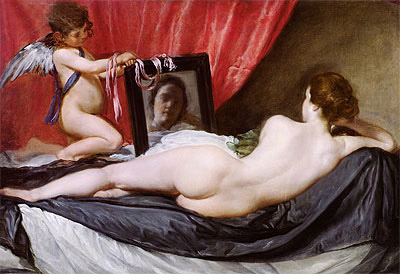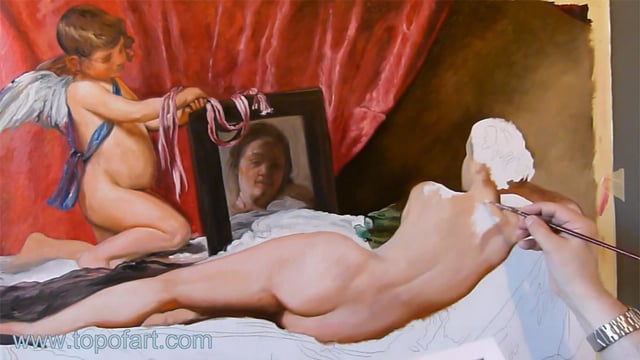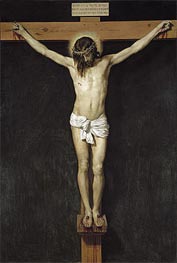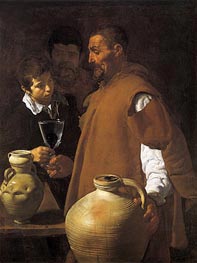The Rokeby Venus (also known as The Toilet of Venus, Venus at her Mirror, Venus and Cupid, or La Venus del espejo) is a painting by Diego Velazquez (1599-1660), the leading artist of the Spanish Golden Age, in the National Gallery, London. Completed between 1647 and 1651, and probably painted during the artist's visit to Italy, the work depicts the goddess Venus in an erotic pose, lying on a bed and looking into a mirror held by the god of sensual love, her son Cupid. Numerous works, from the ancient to the baroque, have been cited as sources of inspiration for Velazquez. The nude Venuses of the Italian painters, such as
Giorgione's Sleeping Venus (c. 1510) and
Titian's
Venus of Urbino (1538), were the main precedents. In this work, Velazquez combined two established poses for Venus: recumbent on a couch or a bed, and gazing at her reflection in a mirror. In a number of ways the painting represents a pictorial departure; through its central use of a mirror, and because it shows the body of Venus turned away from the picture's viewer. The Rokeby Venus is the only surviving female nude by Velazquez. Such works were extremely rare in 17th-century Spanish art, which was actively policed by members of the Spanish Inquisition. Despite this, nudes by foreign artists were keenly collected by the court circle, and this painting adorned the houses of Spanish courtiers until 1813 when it was brought to England to hang in Rokeby Park, Yorkshire. In 1906, the painting was purchased by National Art Collections Fund for the National Gallery, London. Although it was attacked and badly damaged in 1914 by the suffragette Mary Richardson, it was soon fully restored and returned to display.
The painting Description The Rokeby Venus depicts the Roman goddess of love, beauty and fertility reclining languidly on her bed, her back to the viewer in Antiquity, portrayal of Venus from a back view was a common visual and literary erotic motif and her knees tucked. She is shown without the mythological paraphernalia normally included in depictions of the scene; jewellery, roses, and myrtle are all absent. Unlike most earlier portrayals of the goddess, which show her with blond hair, Velazquez's Venus is a brunette. The female figure can be identified as Venus because of the presence of her son, Cupid. Venus gazes into a mirror held by Cupid, who is without his usual bow and arrows. When the work was first inventoried, it was described as "a nude woman"; probably due its controversial nature. Venus looks outward at the viewer of the painting through her reflected image in the mirror. However, the image is blurred and reveals only a vague reflection of her facial characteristics. The critic Natasha Wallace has speculated that Venus's indistinct face may be the key to the underlying meaning of the painting, in that "it is not intended as a specific female nude, nor even as a portrayal of Venus, but as an image of self-absorbed beauty." According to Wallace, "There is nothing spiritual about face or picture. The classical setting is an excuse for a very material aesthetic sexuality not sex, as such, but an appreciation of the beauty that accompanies attraction." Intertwining pink silk ribbons are draped over the mirror and curl over its frame. The ribbon's function has been the subject of much debate by art historians; suggestions include an allusion to the fetters used by Cupid to bind lovers, that it was used to hang the mirror, and that it was used to blindfold Venus moments before. The critic Julian Gallego found Cupid's facial expression to be so melancholy that he believes the ribbons as fetters binding the god to the image of Beauty, and gave the painting the title "Amor conquered by Beauty". The folds of the bed sheets echo the goddess's physical form, and are rendered to emphasise the sweeping curves of her body. The composition mainly uses shades of red, white, and grey, which are used even in Venus's skin; although the effect of this simple colour scheme has been much praised, recent technical analysis has shown that the grey sheet was originally a "deep mauve", that has now faded. The luminescent colours used in Venus's skin, applied with "smooth, creamy, blended handling", contrast with the dark greys and black of the silk she is lying on, and with the brown of the wall behind her face. The Rokeby Venus is the only surviving nude by Velazquez, but three others by the artist are recorded in 17th-century Spanish inventories. Two were mentioned in the Royal collection, but may have been lost in the 1734 fire that destroyed the main Royal Palace of Madrid. A further one was recorded in the collection of Domingo Guerra Coronel. These records mention "a reclining Venus", Venus and Adonis, and a Psyche and Cupid. Although the work is widely thought to have been painted from life, the identity of the model is subject to much speculation. In contemporary Spain it was acceptable for artists to employ male nude models for studies; however, the use of female nude models was frowned upon. The painting is believed to have been executed during one of Velazquez's visits to Rome, and Prater has observed that in Rome the artist "did indeed lead a life of considerable personal liberty that would have been consistent with the notion of using a live nude model female model". The figures of both Venus and Cupid were significantly altered during the painting process, the result of the artist's corrections to the contours as initially painted. Pentimenti can be seen in Venus's upraised arm, in the position of her left shoulder, and on her head. Infra-red reveals that she was originally shown more upright with her head turned to the left. An area on the left of the painting, extending from Venus's left foot to the left leg and foot of Cupid, is apparently unfinished, but this feature is seen in many other works by Velazquez and was probably deliberate. The painting was given a major cleaning and restoration in 1965/66, which showed it to be in good condition, and with very little paint added later by other artists, contrary to what some earlier writers had asserted.
Sources Paintings of nudes and of Venus by Italian, and especially Venetian, artists were influences on Velazquez. However, Velazquez's version is, according to the art historian Andreas Prater, "a highly independent visual concept that has many precursors, but no direct model; scholars have sought them in vain". Forerunners include Titian's various depictions of Venus, such as Venus and Cupid with a Partridge, Venus and Cupid with an Organist and notably the Venus of Urbino; Palma il Vecchio's Reclining Nude; and Giorgione's Sleeping Venus, all of which show the deity reclining on luxurious textiles, although in landscape settings in the latter two works. The use of a centrally placed mirror was inspired by the painters of the Italian High Renaissance, including Titian, Girolamo Savoldo, and Lorenzo Lotto, who used mirrors as an active protagonist, as opposed to more than merely a prop or accessory in the pictorial space. Both Titian and Peter Paul Rubens had already painted Venus looking into a mirror, and as both had had close ties to the Spanish court, their examples would have been familiar to Velazquez. However, "this girl with her small waist and jutting hip, does not resemble the fuller more rounded Italian nudes inspired by ancient sculpture". One innovation, for a large single nude painting, of the Rokeby Venus comes in the fact that it shows a back view of its subject who is turned away from the viewer. There were precedents for this in prints by Giulio Campagnola, Agostino Veneziano, Hans Sebald Beham and Theodor de Bry, as well as classical sculptures known to Velazquez, of which casts were in Madrid. These were the Sleeping Ariadne now in the Pitti Palace, but then in Rome, of which Velazquez ordered a cast for the Royal collection in 1650/51, and the Borghese Hermaphroditus, a sleeping hermaphrodite (picture above), now in the Louvre, of which a cast was also sent to Madrid, and which also emphasises the curve from hip to waist. However the combination of elements in Velazquez's composition was original. The Rokeby Venus may have been intended as a pendant to a 16th-century Venetian painting of a recumbent Venus (which seems to have begun life as a Danae) in a landscape, in the same pose, but seen from the front. The two were certainly hung together for many years in Spain when in the collection of Gaspar Mendez de Haro y Guzman (1629/87), the seventh Marquis of Carpio; at what point they were initially paired is uncertain.
Nudes in 17th-century Spain The portrayal of nudes was officially discouraged in 17th-century Spain. Works could be seized or repainting demanded by the Inquisition, and artists who painted licentious or immoral works could be excommunicated, and fined or banished from Spain for a year. However, within intellectual and aristocratic circles, the aims of art were believed to supersede questions of morality, and there were many, generally mythological, nudes in private collections. Velazquez's patron, the art-loving King Philip IV, held a number of nudes by Titian and Rubens in his collection, and Velazquez, as the king's painter, need not have feared painting a nude. Leading collectors, including the King, tended to keep nudes, many mythological, together in a relatively private room; in Phillip's case "the room where His Majesty retires after eating", which contained the Titian poesies he had inherited from Phillip II, and the Rubens he had commissioned himself. The Venus would be in such a room while in the collections of both Haro and Godoy. The court of Philip IV greatly "appreciated painting in general, and the nude in particular, but ... at the same time, exerted unparalleled pressure on artists to avoid the depiction of the naked human body." The contemporary Spanish attitude toward paintings of nudes was unique in Europe. Although such works were appreciated by some connoisseurs and intellectuals within Spain, they were generally treated with suspicion. Low necklines were commonly worn by women during the period, but according to the art historian Zahira Veliz, "the codes of pictorial decorum would not easily permit a known lady to be painted in this way". For Spaniards of the 17th century, the issue of the nude in art was tied up with concepts of morality, power, and aesthetics. This attitude is reflected in the literature of the Spanish Golden Age, in works such as Lope de Vega's play La quinta de Florencia, which features an aristocrat who commits rape after viewing a scantily clad figure in a mythological painting by Michelangelo. In 1632, an anonymous pamphlet - attributed to the Portuguese Francisco de Braganza - was published with the title "A copy of the opinions and censorship by the most revered fathers, masters and senior professors of the distinguished universities of Salamanca and Alcala, and other scholars on the abuse of lascivious and indecent figures and paintings, which are mortal sin to be painted, carved and displayed where they can be seen". The court was able to exert counter-pressure, and a piece by the famous poet and preacher Fray Hortensio Felix Paravicino, which proposed the destruction of all paintings of the nude, and was written to be included in the pamphlet, was never published. Paravicino was a connoisseur of painting, and therefore believed in its power: "the finest paintings are the greatest threat: burn the best of them". As his title shows, Braganza merely argued that such works should be kept from the view of a wider public, as was in fact mostly the practice in Spain. In contrast, French art of the period often depicted women with low necklines and slender corsets; however, the apparent destruction by the French royal family of the famous paintings of Leda and the Swan by Leonardo da Vinci and Michelangelo, as well as the mutilation of the Correggio composition, show that nudity could be controversial in France also. In northern Europe it was seen as acceptable to portray artfully draped nudes. Examples include Rubens's Minerva Victrix, of 1622/25, which shows Marie de' Medici with an uncovered breast, and Anthony van Dyck's 1620 painting, The Duke and Duchess of Buckingham as Venus and Adonis. In 17th-century Spanish art, even in the depiction of sibyls, nymphs, and goddesses, the female form was always chastely covered. No painting from the 1630s or 1640s, whether in the genre, portrait, or history format, shows a Spanish female with her breasts exposed; even uncovered arms were only rarely shown. In 1997, the art historian Peter Cherry suggested that Velazquez sought to overcome the contemporary requirement for modesty by portraying Venus from the back. Even in the mid-eighteenth century, an English artist who made a drawing of the Venus when it was in the collection of the Dukes of Alba noted it was "not hung up, owing to the subject". Another attitude to the issue was shown by Morritt, who wrote to Sir Walter Scott of his "fine painting of Venus' backside", which he hung above his main fireplace, so that "the ladies may avert their downcast eyes without difficulty and connoisseurs steal a glance without drawing the said posterior into the company".
Provenance The Rokeby Venus was long held to be one of Velazquez's final works. In 1951, it was found recorded in an inventory of June 1, 1651 from the collection of Gaspar Mendez de Haro y Guzman, a close associate of Philip IV of Spain. Haro was the great-nephew of Velazquez's first patron, the Count-Duke of Olivares, and a notorious libertine. According to the art historian Dawson Carr, Haro "loved paintings almost as much as he loved women", and "even his panegyrists lamented his excessive taste for lower-class women during his youth". For these reasons it seemed likely that he would have commissioned the painting. However, in 2001 the art historian Angel Aterido discovered that the painting had first belonged to the Madrid art dealer and painter Domingo Guerra Coronel, and was sold to Haro in 1652 following Coronel's death the previous year. Coronel's ownership of the painting raises a number of questions: how and when it came into Coronel's possession, and why Velazquez's name was omitted from Coronel's inventory. The art critic Javier Portus has suggested that the omission may have been due to the painting's portrayal of a female nude, "a type of work which was carefully supervised and whose dissemination was considered problematic". These revelations make the painting difficult to date. Velazquez's painting technique offers no assistance, although its strong emphasis on colour and tone suggest that the work dates from his mature period. The best estimates of its origin put its completion in the late 1640s or early 1650s, either in Spain or during Velazquez's last visit to Italy. If this is the case, then the breadth of handling and the dissolution of form can be seen to mark the beginning of the artist's final period. The conscientious modelling and strong tonal contrasts of his earlier work are here replaced by a restraint and subtlety which would culminate in his late masterpiece, Las Meninas. The painting passed from Haro into the collection of his daughter Catalina de Haro y Guzman, the eighth Marchioness of Carpio, and her husband, Francisco Alvarez de Toledo, the tenth Duke of Alba. In 1802, Charles IV of Spain ordered the family to sell the painting (with other works) to Manuel de Godoy, his favourite and chief minister. He hung it alongside two masterpieces by Francisco Goya that he may have commissioned himself, The Nude Maja and The Clothed Maja. These bear obvious compositional similarities with Velazquez's Venus, although unlike Velazquez, Goya clearly painted his nude in a calculated attempt to provoke shame and disgust in the relatively unenlightened climate of 18th-century Spain. Venus was brought to England in 1813, where it was purchased (for £500, and on the advice of his friend Sir Thomas Lawrence) by John Morritt, who hung it in his house at Rokeby Park, Yorkshire thus the painting's popular name. In 1906, the painting was acquired for the National Gallery by the newly created National Art Collections Fund, its first campaigning triumph. King Edward VII greatly admired the painting, and anonymously provided £8,000 towards its purchase, and became Patron of the Fund thereafter.
Legacy In part due to being overlooked until the mid-19th century, Velazquez found no followers and was not widely imitated. In particular, his visual and structural innovations in this portrayal of Venus were not developed by other artists until recently, largely due to the censorship of the work. The painting remained in a series of private rooms in private collections until it was exhibited in 1857 at the Manchester Art Treasures Exhibition, along with 25 other paintings at least claimed to be by Velazquez; it was here that it became known as the Rokeby Venus. It does not appear to have been copied by other artists, engraved or otherwise reproduced, until this period. In 1890 it was exhibited in the Royal Academy in London, and in 1905 at Messrs. Agnews, the dealers who had bought it from Morritt. From 1906 it was highly visible in the National Gallery and became well-known globally through reproductions. The general influence of the painting was therefore long delayed, although individual artists would have been able to see it on occasion throughout its history. Velazquez's portrait is a staging of a private moment of intimacy and a dramatic departure from the classical depictions of sleep and intimacy found in works from antiquity and Venetian art that portray Venus. However, the simplicity with which Velazquez displays the female nude without jewellery or any of the goddess's usual accessories was echoed in later nude studies by
Ingres,
Manet, and Baudry, among others. In addition, Velazquez's depiction of Venus as a reclining nude viewed from the rear was a rarity before that time, although the pose has been painted by many later artists. Manet, in his stark female portrayal
Olympia, paraphrased the Rokeby Venus in pose and by suggesting the persona of a real woman rather than an ethereal goddess. Olympia shocked the Parisian art world when it was first exhibited in 1863. Olympia gazes directly out at the viewer, as does Velazquez's Venus, only through the reflection of the mirror.
Vandalism On March 10, 1914, the militant suffragette Mary Richardson walked into the National Gallery and attacked Velazquez's canvas with a meat cleaver. Her action was ostensibly provoked by the arrest of fellow suffragette Emmeline Pankhurst the previous day, although there had been earlier warnings of a planned suffragette attack on the collection. Richardson left seven slashes on the painting, causing damage to the area between the figure's shoulders. However, all were successfully repaired by the National Gallery's chief restorer Helmut Ruhemann. Richardson was sentenced to six months' imprisonment, the maximum allowed for destruction of an artwork. In a statement to the Women's Social and Political Union shortly afterwards, Richardson explained, "I have tried to destroy the picture of the most beautiful woman in mythological history as a protest against the Government for destroying Mrs. Pankhurst, who is the most beautiful character in modern history." She added in a 1952 interview that she "didn't like the way men visitors gaped at it all day long". The feminist writer Lynda Nead has observed that although "the incident has come to symbolize a particular perception of feminist attitudes towards the female nude; in a sense, it has come to represent a specific stereotypical image of feminism more generally". Contemporary reports of the incident reveal that the picture was not widely seen in a purely humanistic and enlightened manner. Journalists tended to assess the attack in terms of a murder (Richardson was nicknamed "Slasher Mary"), and used words that conjured wounds inflicted on an actual female body, rather than on a pictorial representation of a female body. The Times, in an article that contained factual inaccuracies as to the painting's provenance, described a "cruel wound in the neck", as well as incisions to the shoulders and back.

 The Rokeby Venus - Video
The Rokeby Venus - Video




